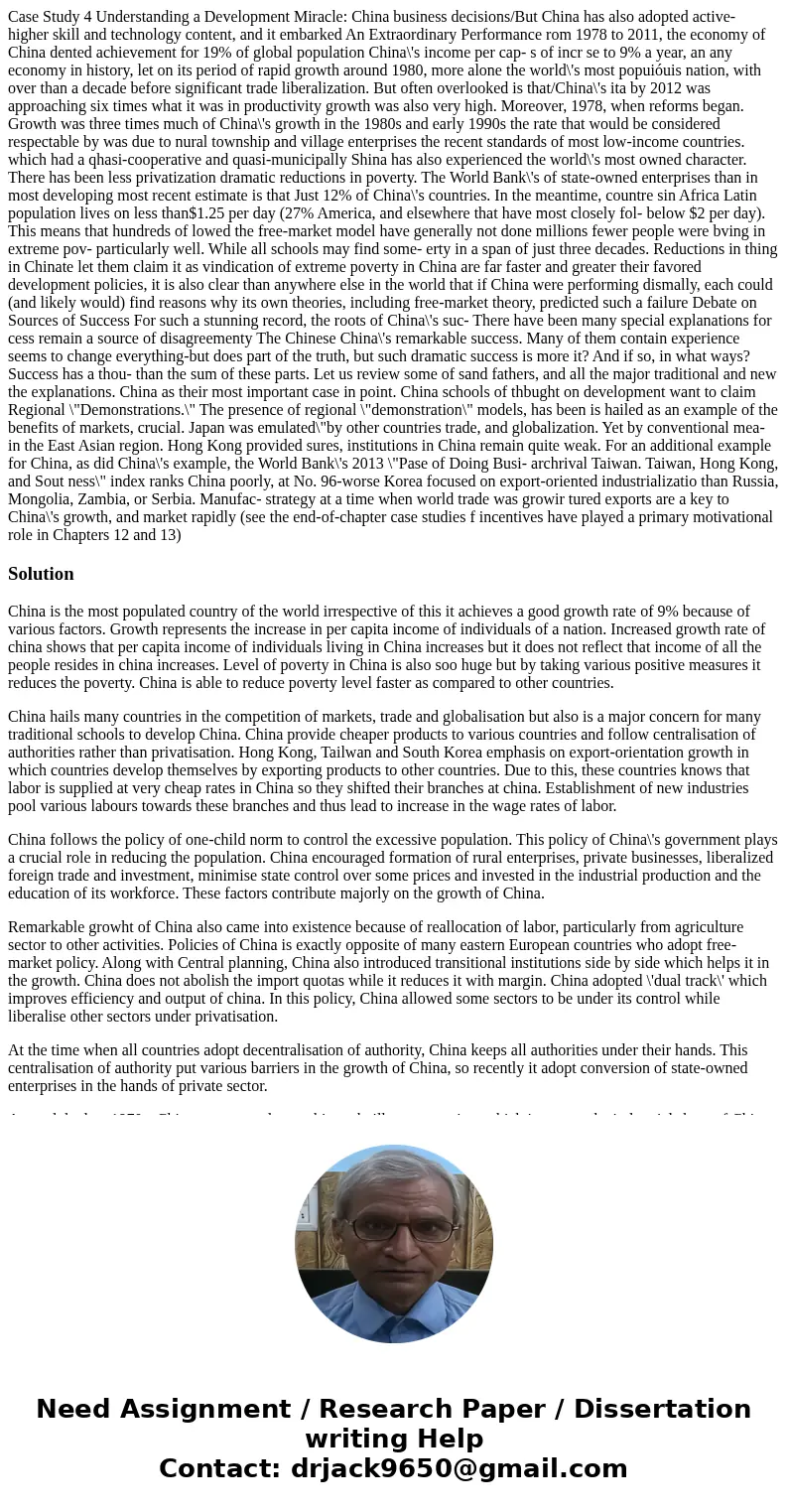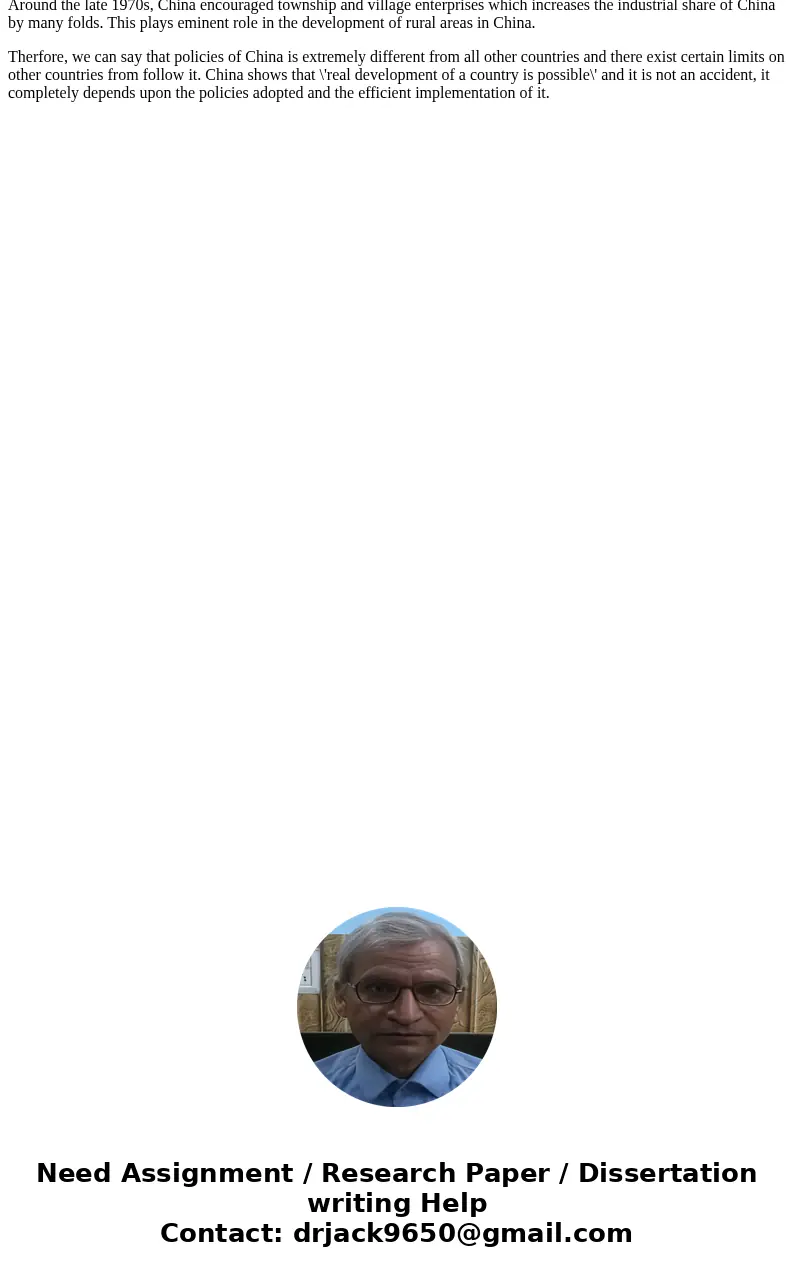Case Study 4 Understanding a Development Miracle: China business decisions/But China has also adopted active- higher skill and technology content, and it embarked An Extraordinary Performance rom 1978 to 2011, the economy of China dented achievement for 19% of global population China\'s income per cap- s of incr se to 9% a year, an any economy in history, let on its period of rapid growth around 1980, more alone the world\'s most popuióuis nation, with over than a decade before significant trade liberalization. But often overlooked is that/China\'s ita by 2012 was approaching six times what it was in productivity growth was also very high. Moreover, 1978, when reforms began. Growth was three times much of China\'s growth in the 1980s and early 1990s the rate that would be considered respectable by was due to nural township and village enterprises the recent standards of most low-income countries. which had a qhasi-cooperative and quasi-municipally Shina has also experienced the world\'s most owned character. There has been less privatization dramatic reductions in poverty. The World Bank\'s of state-owned enterprises than in most developing most recent estimate is that Just 12% of China\'s countries. In the meantime, countre sin Africa Latin population lives on less than$1.25 per day (27% America, and elsewhere that have most closely fol- below $2 per day). This means that hundreds of lowed the free-market model have generally not done millions fewer people were bving in extreme pov- particularly well. While all schools may find some- erty in a span of just three decades. Reductions in thing in Chinate let them claim it as vindication of extreme poverty in China are far faster and greater their favored development policies, it is also clear than anywhere else in the world that if China were performing dismally, each could (and likely would) find reasons why its own theories, including free-market theory, predicted such a failure Debate on Sources of Success For such a stunning record, the roots of China\'s suc- There have been many special explanations for cess remain a source of disagreementy The Chinese China\'s remarkable success. Many of them contain experience seems to change everything-but does part of the truth, but such dramatic success is more it? And if so, in what ways? Success has a thou- than the sum of these parts. Let us review some of sand fathers, and all the major traditional and new the explanations. China as their most important case in point. China schools of thbught on development want to claim Regional \"Demonstrations.\" The presence of regional \"demonstration\" models, has been is hailed as an example of the benefits of markets, crucial. Japan was emulated\"by other countries trade, and globalization. Yet by conventional mea- in the East Asian region. Hong Kong provided sures, institutions in China remain quite weak. For an additional example for China, as did China\'s example, the World Bank\'s 2013 \"Pase of Doing Busi- archrival Taiwan. Taiwan, Hong Kong, and Sout ness\" index ranks China poorly, at No. 96-worse Korea focused on export-oriented industrializatio than Russia, Mongolia, Zambia, or Serbia. Manufac- strategy at a time when world trade was growir tured exports are a key to China\'s growth, and market rapidly (see the end-of-chapter case studies f incentives have played a primary motivational role in Chapters 12 and 13)
China is the most populated country of the world irrespective of this it achieves a good growth rate of 9% because of various factors. Growth represents the increase in per capita income of individuals of a nation. Increased growth rate of china shows that per capita income of individuals living in China increases but it does not reflect that income of all the people resides in china increases. Level of poverty in China is also soo huge but by taking various positive measures it reduces the poverty. China is able to reduce poverty level faster as compared to other countries.
China hails many countries in the competition of markets, trade and globalisation but also is a major concern for many traditional schools to develop China. China provide cheaper products to various countries and follow centralisation of authorities rather than privatisation. Hong Kong, Tailwan and South Korea emphasis on export-orientation growth in which countries develop themselves by exporting products to other countries. Due to this, these countries knows that labor is supplied at very cheap rates in China so they shifted their branches at china. Establishment of new industries pool various labours towards these branches and thus lead to increase in the wage rates of labor.
China follows the policy of one-child norm to control the excessive population. This policy of China\'s government plays a crucial role in reducing the population. China encouraged formation of rural enterprises, private businesses, liberalized foreign trade and investment, minimise state control over some prices and invested in the industrial production and the education of its workforce. These factors contribute majorly on the growth of China.
Remarkable growht of China also came into existence because of reallocation of labor, particularly from agriculture sector to other activities. Policies of China is exactly opposite of many eastern European countries who adopt free-market policy. Along with Central planning, China also introduced transitional institutions side by side which helps it in the growth. China does not abolish the import quotas while it reduces it with margin. China adopted \'dual track\' which improves efficiency and output of china. In this policy, China allowed some sectors to be under its control while liberalise other sectors under privatisation.
At the time when all countries adopt decentralisation of authority, China keeps all authorities under their hands. This centralisation of authority put various barriers in the growth of China, so recently it adopt conversion of state-owned enterprises in the hands of private sector.
Around the late 1970s, China encouraged township and village enterprises which increases the industrial share of China by many folds. This plays eminent role in the development of rural areas in China.
Therfore, we can say that policies of China is extremely different from all other countries and there exist certain limits on other countries from follow it. China shows that \'real development of a country is possible\' and it is not an accident, it completely depends upon the policies adopted and the efficient implementation of it.


 Homework Sourse
Homework Sourse